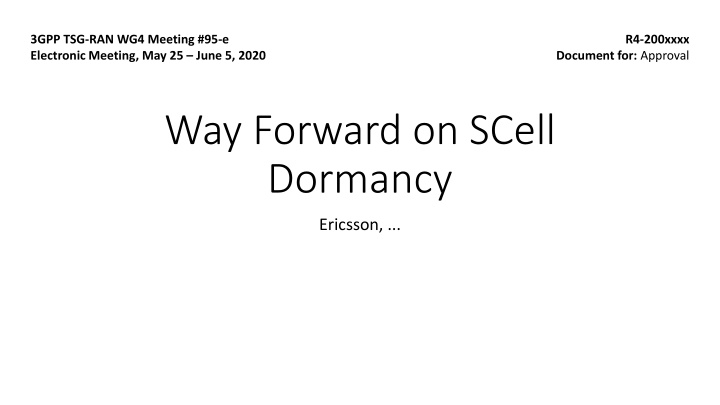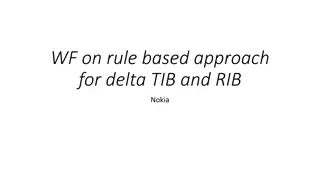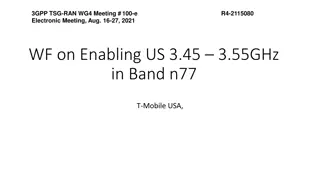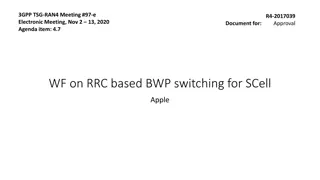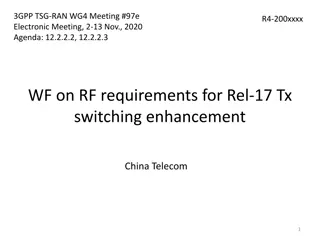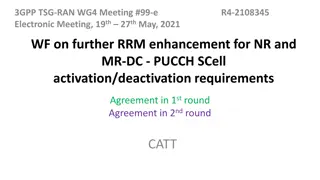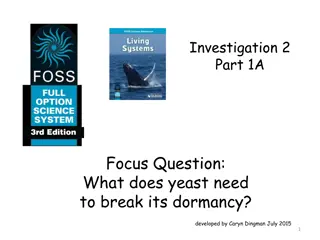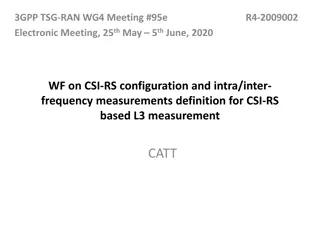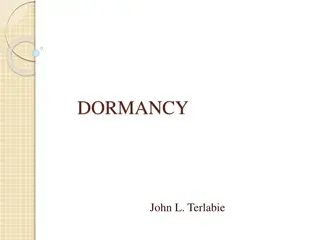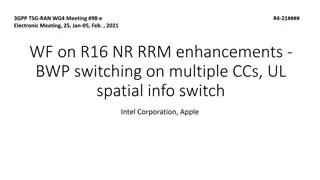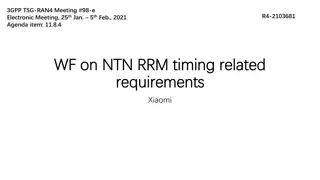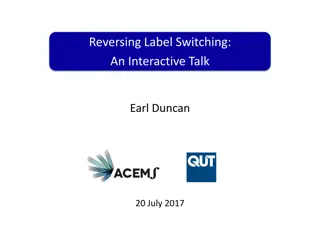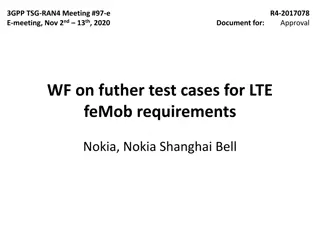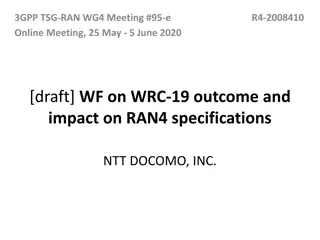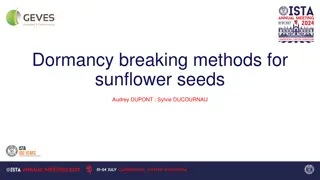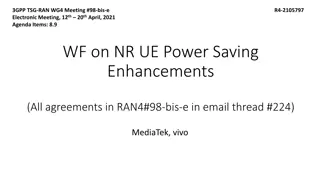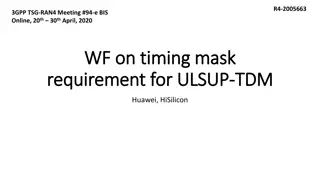Discussion on SCell Dormancy and Switching in RAN4#95e Meeting
At the recent RAN4#95e meeting, various topics related to SCell dormancy and switching were discussed, including delays in transitioning between dormancy and non-dormancy states, interruptions during switching, and CSI/RRM measurements during dormancy. Agreement was reached on switching conditions based on parameter changes, DCI-based triggering, and timing considerations. The meeting aimed to address issues related to UE RRM requirements for dormancy SCell.
Download Presentation

Please find below an Image/Link to download the presentation.
The content on the website is provided AS IS for your information and personal use only. It may not be sold, licensed, or shared on other websites without obtaining consent from the author.If you encounter any issues during the download, it is possible that the publisher has removed the file from their server.
You are allowed to download the files provided on this website for personal or commercial use, subject to the condition that they are used lawfully. All files are the property of their respective owners.
The content on the website is provided AS IS for your information and personal use only. It may not be sold, licensed, or shared on other websites without obtaining consent from the author.
E N D
Presentation Transcript
3GPP TSG-RAN WG4 Meeting #95-e Electronic Meeting, May 25 June 5, 2020 R4-200xxxx Document for: Approval Way Forward on SCell Dormancy Ericsson, ...
Background At RAN4#94e, agreements on SCell dormancy were captured in R4-2002238 WF on UE RRM requirements for dormancy SCell At RAN4#94e-Bis, agreements on SCell dormancy were captured in R4-2005329 Way Forward on SCell Dormancy
Background At RAN4#95e, the following topics were discussed: Sub-topic 2-1: Switching of single SCell between dormancy and non-dormancy, triggering inside active time Issue 2-1-1: Switching delay non-dormancy to dormancy, general case w.r.t. parameter change Issue 2-1-2: Switching delay non-dormancy to dormancy, optimized w.r.t. parameter change Issue 2-1-3: Switching delay dormancy to non-dormancy, general case w.r.t. parameter change Issue 2-1-4: Switching delay dormancy to non-dormancy, optimized w.r.t. parameter change Issue 2-1-5: Interruption at switching between dormancy and non-dormancy Sub-topic 2-2: Switching of single SCell between dormancy and non-dormancy, triggering outside active time Issue 2-2-1: Switching delay between dormancy and non-dormancy Issue 2-2-2: Interruption at switching between dormancy and non-dormancy Sub-topic 2-4: CSI and RRM measurements during dormancy Issue 2-4-1: Measurement requirements Issue 2-4-2: Interruptions
2 2- -1 1- -1: Switching delay non 1: Switching delay non- -dormancy to dormancy, general case dormancy to dormancy, general case w.r.t. w.r.t. parameter change (1/2) [Inside active time] parameter change (1/2) [Inside active time] Agreement: For general case w.r.t. parameter change, and conditioned on that DCI is received within the first 3 OFDM symbols, switching between non-dormancy and dormancy follows the Rel-15 BWP switching time in Table 8.6.2-1.
2 2- -1 1- -1: Switching delay non 1: Switching delay non- -dormancy to dormancy, general case dormancy to dormancy, general case w.r.t. w.r.t. parameter change (2/2) [Inside active time] parameter change (2/2) [Inside active time] Agreement: For DCI-based triggering with DCI received in any of the first X OFDM symbols of a slot, and for timer-based triggering, the switching delay for transition from non-dormancy to dormancy is given by Table 8.6.2-1. For DCI-based triggering with DCI received after the first X OFDM symbols of a slot, if applicable, the switching delay for transition from non-dormancy to dormancy is given by Table 8.6.2-1 plus Z additional slot(s). For value of X: Option 1a (Ericsson, Qualcomm, Nokia, NEC, Huawei, Vivo): X = 3 symbols Option 1b (MTK): X = 7 symbols For value of Z: Option 2a (Ericsson, Qualcomm, Nokia, NEC, MTK, Huawei, Vivo): Z = 1 slot Option 2c (ZTE): Z = 0 slot In case SCS differs between spCell and SCell, the switching delay, except for Z slot(s), associated with the smaller SCS applies. Z additional slot(s) follows the serving cell numerology from which the UE received (non-)dormant BWP transition DCI.
2 2- -1 1- -2: Switching delay non 2: Switching delay non- -dormancy to dormancy, optimized dormancy to dormancy, optimized w.r.t. w.r.t. parameter change [Inside active time] parameter change [Inside active time] For further discussion: Option 1 (Ericsson, Qualcomm, Nokia, ZTE, NEC): Only introduce generic requirements. Optimizations can be introduced as future enhancements. Option 2 (Huawei, Vivo, MTK): Rel-15 Type-1 BWP switch delay apply for dormancy switch if only parameters for PDCCH monitoring and CSI-RS reporting differ between regular BWP and dormant BWP.
2 2- -1 1- -3: Switching delay dormancy to non 3: Switching delay dormancy to non- -dormancy, general case w.r.t. w.r.t. parameter change [Inside active time] parameter change [Inside active time] dormancy, general case Agreement: The dormancy switching delay for switching between dormancy and non- dormancy is same as for switching between non-dormancy and dormancy. (Conclusion for 2-1-1 applies here too)
2 2- -1 1- -4: w.r.t. w.r.t. parameter change [Inside active time] parameter change [Inside active time] 4: Switching delay dormancy to non Switching delay dormancy to non- -dormancy, optimized dormancy, optimized Agreement: The dormancy switching delay for switching between dormancy and non- dormancy is same as for switching between non-dormancy and dormancy. (Conclusion for 2-1-2 applies here too)
2 2- -1 1- -5: dormancy [Inside active time] dormancy [Inside active time] 5: Interruption at switching between dormancy and non Interruption at switching between dormancy and non- - For further discussion: Option 1 (Huawei): Rel-15 BWP switch interruption requirements apply for dormancy switch triggered within DRX active time. Interruption additionally allowed for toggling RF on/off. Option 2 (Qualcomm, Vivo, Ericsson, Nokia, ZTE, NEC): Interruption length as in Table 8.2.2.2.5-1 applies. The interruption time window is confined within the BWP switching delay for transition between dormancy and non-dormancy. If UE is capable of per-FR gap, UE is allowed to cause interruption of up to X slot to other active serving cells in the same frequency range. If UE is not capable of per-FR gap, UE is allowed to cause interruption of up to X slot to other active serving cells. Interruptions are allowed regardless of which parameters change between dormancy and non-dormancy. Option 3 (MTK): Follow normal BWP change interruption requirements, i.e., no interruption when neither of locationAndBandwidth, nrofSRS-Ports, maxMIMO-Layers, or SCS, changes.
1: Switching delay between dormancy and Switching delay between dormancy and non non- -dormancy dormancy [Outside active time] 2 2- -2 2- -1: [Outside active time] For further discussion: Option 1 (Vivo, Ericsson, MTK, Qualcomm, Nokia, NEC): Same set of switch delay requirements shall apply for triggering outside active time (DCI 2_6) as for triggering inside active time (e.g. DCI 0_1). Option 2 (ZTE, Huawei): BWP switch delay for scheduled and non-scheduled DCI dormancy switch delay would be covered by the DCI BWP switch delay requirement. WUS based dormancy BWP switch does not lead to visible switch delay provided the WUS is received early enough before On-duration. Option 3 (Huawei): RAN4 to further wait for RAN1 conclusion to see if visible delay and interruption requirements are needed.
2 2- -2 2- -2: dormancy [Outside active time] dormancy [Outside active time] 2: Interruption at switching between dormancy and non Interruption at switching between dormancy and non- - For further discussion: Option 1 (Qualcomm, Ericsson, Nokia, ZTE, NEC, MTK, Vivo): Same interruption requirement apply for outside as for inside active time. Option 2 (Huawei): RAN4 to wait for RAN1 conclusions before defining interruption requirements for dormancy switch triggered outside DRX active time.
2 2- -4 4- -1: measurements during dormancy measurements during dormancy 1: Measurement requirements for CSI and RRM Measurement requirements for CSI and RRM Agreement: UE measurement requirements are same for dormant as for non- dormant SCell.
2 2- -4 4- -2: dormancy dormancy 2: Interruptions for CSI and RRM measurements during Interruptions for CSI and RRM measurements during For further discussion: Option 1 (Vivo, Nokia, Huawei): The legacy principle of LTE can be reused and total interruption requirements for CSI and RRM measurement during SCell dormancy shall not exceed a particular percentage value. Option 2 (Qualcomm, Vivo, Ericsson, MTK, NEC): For Interruptions due to SSB-based measurements and CSI- RS reception, Interruptions are allowed with up to X% probability of missed ACK/NACK with the following conditions The UE is only allowed to cause interruptions immediately before and after an SMTC. Each interruption shall not exceed requirement in Table 8.2.2.2.2-1 if victim cells are not in the same band as the aggressor SCell. Each interruption shall not exceed requirement in Table 8.2.2.2.2-2 if victim cells is in the same band as the aggressor SCell. Interruptions are allowed with up to Y% probability of missed ACK/NACK with the following conditions The UE is only allowed to cause interruptions immediately before and after an CSI-RS OFDM symbol. Each interruption shall not exceed requirement in Table 8.2.2.2.2-1. Option 3 (ZTE): Specify interruption length and interruption rate rather than missed ACK/NACK rate.
For RAN4#96e Interested companies are encouraged to provide further analyses on: ...<depends on final list of open issues>
